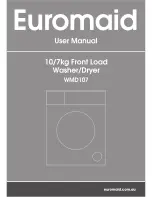
3
Disposal
Dispose of the dishwasher packaging material correctly.
All packaging materials can be recycled.
Plastic parts are marked with standard international
abbreviations:
>PE<
for polyethylene, e.g. sheet wrapping material.
>PS<
for polystyrene, e.g. padding material (always CFC-
free).
>POM< for polyoxymethylene, e.g. plastic clips.
Cardboard packaging is manufactured from recycled paper
and should be deposited in the waste paper collection for
recycling.
As and when you cease to use your dishwasher and withdraw
it from service, your should render it unserviceable before
having it disposed of.
Warning! Children at play could lock themselves in your
dishwasher or otherwise endanger their lives. Therefore cut off
the power supply cable and make the door closing device
unusable to prevent children from being trapped inside.
For the disposing of the appliance please take it to a recycling
centre or to your dealer who will, for a small contribution to the
costs, dispose it for you.
Economical and
ecological dishwashing
●
Ensure that the water softener is correctly adjusted.
●
Do not pre-wash under running water.
●
Select the wash programme to suit the nature and degree of
the soiling on the dishes.
●
Do not use more detergent, special salt and rinse aid than is
recommended in these operating instructions and by the
manufacturer of the respective product.
Prior to using for the first time
Before using your dishwasher for the first time:
1. Ensure that the electrical and water connections comply
with the installation instructions
2. Remove all packaging from inside the appliance
3. Set the water softener
4. Pour 1 litre of water inside the salt container and then fill
with salt
5. Fill the rinse aid dispenser
6. Run a "Rinse and Hold" programme (not all models of
dishwashers are foreseen with this programme)
The water softener
The dishwasher is equipped with a water softener designed to
remove minerals and salts from the water supply, which would
have a detrimental or adverse effect on the operation of the
appliance.
The higher the content of these salts, the harder your water is.
Water hardness is measured in equivalent scales, German
degrees, French degrees and PPM (parts per Million).
The softener should be adjusted according to the hardness of
the water in your area. Your local Water Authority can advise
you on the hardness of the water in your area.
The dishwasher is factory set at position 2.
If your water is below level 1 it is already soft and therefore
there is no need to use salt. In this case adjust the water
softener on level 1 without using salt.
Only for dishwasher models with salt refilling
indicator light:
If the water softener has been adjusted on level 1 and no salt
is being used, the salt refilling indicator light on the control
panel, will always remain illuminated when the machine is
switched on.
Setting the water softener
1. Open the dishwasher door.
2. Remove the lower basket from the dishwasher.
3. Turn the water hardness switch until the required level (see
table) corresponds with the marker .
4. Replace the lower basket.
Filling with salt
Special salt can be added in one of two ways:
●
If you are using dishwasher detergent that already contains
salt, the detergent including the salt is placed in the
detergent compartment.
- In this case the water softener must be set to level 1 to
ensure that the special salt is taken from the detergent
container only.
●
If you are using dishwasher detergent and salt separately,
the special salt is to be put into the salt container.
- In this case the water softener must be set to between
level 1 and 5 (depending on the water hardness in your
area) to ensure that the special salt is taken from the salt
container only.
AA08
PPM
parts per million
°TH
french degrees
°dH
german degrees
41 - 50
30 - 40
19 - 29
4 - 18
< 4
71 - 90
51 - 70
31 - 50
8 - 30
< 8
701 - 900
501 - 700
301 - 500
80 - 300
< 80
level 5
level 4
level 3
level 2
level 1
yes
yes
yes
yes
no
Water hardness
Water
hardness
setting
Use of
salt






































